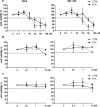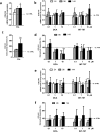Obeticholic acid and INT-767 modulate collagen deposition in a NASH in vitro model
- PMID: 32015483
- PMCID: PMC6997404
- DOI: 10.1038/s41598-020-58562-x
Obeticholic acid and INT-767 modulate collagen deposition in a NASH in vitro model
Abstract
Pharmacological treatments for non-alcoholic steatohepatitis (NASH) are still unsatisfactory. Fibrosis is the most significant predictor of mortality and many anti-fibrotic agents are under evaluation. Herein, we assessed in vitro the effects of the FXR agonist obeticholic acid (OCA) and the dual FXR/TGR5 agonist INT-767 in a well-established co-culture NASH model. Co-cultures of human hepatoma and hepatic stellate (HSCs) cells were exposed to free fatty acids (FFAs) alone or in combination with OCA or INT-767. mRNA expression of HSCs activation markers and FXR engagement were evaluated at 24, 96 and 144 hours. Collagen deposition and metalloproteinase 2 and 9 (MMP2-9) activity were compared to tropifexor and selonsertib. FFAs induced collagen deposition and MMP2-9 activity reduction. Co-treatment with OCA or INT-767 did not affect ACTA2 and COL1A1 expression, but significantly reduced FXR and induced SHP expression, as expected. OCA induced a dose-dependent reduction of collagen and induced MMP2-9 activity. Similarly, INT-767 induced collagen reduction at 96 h and a slight increase in MMP2-9. Tropifexor and Selonsertib were also effective in collagen reduction but showed no modulation of MMP2-9. All tested compounds reduced collagen deposition. OCA exerted a more potent and long-lasting effect, mainly related to modulation of collagen turn-over and MMP2-9 activity.
Conflict of interest statement
This research was funded by Intercept Pharmaceuticals, Inc. The funders had no role in the design of the study; in the collection, analyses, or interpretation of data; in the writing of the manuscript, or in the decision to publish the results. L.A. is an Intercept Pharmaceutical consultant. B.A., C.T., N.R. have no conflict of interest to declare.
Figures







Similar articles
-
INT-767 improves histopathological features in a diet-induced ob/ob mouse model of biopsy-confirmed non-alcoholic steatohepatitis.World J Gastroenterol. 2018 Jan 14;24(2):195-210. doi: 10.3748/wjg.v24.i2.195. World J Gastroenterol. 2018. PMID: 29375205 Free PMC article.
-
FXR agonists INT-787 and OCA increase RECK and inhibit liver steatosis and inflammation in diet-induced ob/ob mouse model of NASH.Liver Int. 2024 Jan;44(1):214-227. doi: 10.1111/liv.15767. Epub 2023 Oct 30. Liver Int. 2024. PMID: 37904642
-
Increased hepatoprotective effects of the novel farnesoid X receptor agonist INT-787 versus obeticholic acid in a mouse model of nonalcoholic steatohepatitis.PLoS One. 2024 Apr 25;19(4):e0300809. doi: 10.1371/journal.pone.0300809. eCollection 2024. PLoS One. 2024. PMID: 38662778 Free PMC article.
-
Obeticholic acid-a new therapy in PBC and NASH.Br Med Bull. 2020 May 15;133(1):95-104. doi: 10.1093/bmb/ldaa006. Br Med Bull. 2020. PMID: 32282030 Review.
-
Obeticholic Acid: An Update of Its Pharmacological Activities in Liver Disorders.Handb Exp Pharmacol. 2019;256:283-295. doi: 10.1007/164_2019_227. Handb Exp Pharmacol. 2019. PMID: 31201552 Review.
Cited by
-
Gut microbiota, immunity, and bile acid metabolism: decoding metabolic disease interactions.Life Metab. 2023 Jul 23;2(6):load032. doi: 10.1093/lifemeta/load032. eCollection 2023 Dec. Life Metab. 2023. PMID: 39872860 Free PMC article. Review.
-
Exploring hepatic stellate cell-driven fibrosis: therapeutic advances and future perspectives.ADMET DMPK. 2025 Aug 4;13(4):2874. doi: 10.5599/admet.2874. eCollection 2025. ADMET DMPK. 2025. PMID: 40786064 Free PMC article. Review.
-
Pathophysiological Relationship between Type 2 Diabetes Mellitus and Metabolic Dysfunction-Associated Steatotic Liver Disease: Novel Therapeutic Approaches.Int J Mol Sci. 2024 Aug 10;25(16):8731. doi: 10.3390/ijms25168731. Int J Mol Sci. 2024. PMID: 39201418 Free PMC article. Review.
-
Nuclear hormone and peptide hormone therapeutics for NAFLD and NASH.Mol Metab. 2021 Apr;46:101153. doi: 10.1016/j.molmet.2020.101153. Epub 2020 Dec 23. Mol Metab. 2021. PMID: 33359400 Free PMC article. Review.
-
Insights into the gut-liver axis: mechanisms and emerging therapies in hepatocellular carcinoma.Front Pharmacol. 2025 May 19;16:1595853. doi: 10.3389/fphar.2025.1595853. eCollection 2025. Front Pharmacol. 2025. PMID: 40458800 Free PMC article. Review.
References
-
- Araújo AR, Rosso N, Bedogni G, Tiribelli C, Bellentani S. Global epidemiology of non-alcoholic fatty liver disease/non-alcoholic steatohepatitis: What we need in the future. Liver Int. Off. J. Int. Assoc. Study Liver. 2018;38(Suppl 1):47–51. - PubMed
Publication types
MeSH terms
Substances
LinkOut - more resources
Full Text Sources
Medical
Miscellaneous

